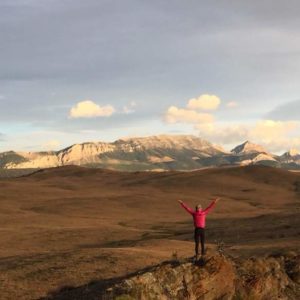 As I walked through the blackened and bare burn area of the Scapegoat Wilderness, I contemplated how my view of fire ecology and wildfire had completely changed. Before my Montana adventures, I associated wildfire with destruction, terror, and human loss. In my home state of California, massive unnaturally large wildfires have been raging every summer for the last couple years due to severe drought conditions and the fire suppression policies that began in 1906 with the creation of the Forest Service. However, our instructor Trevor, who does research in fire ecology, opened my eyes to the regenerative qualities of wildfire in an ecosystem.
As I walked through the blackened and bare burn area of the Scapegoat Wilderness, I contemplated how my view of fire ecology and wildfire had completely changed. Before my Montana adventures, I associated wildfire with destruction, terror, and human loss. In my home state of California, massive unnaturally large wildfires have been raging every summer for the last couple years due to severe drought conditions and the fire suppression policies that began in 1906 with the creation of the Forest Service. However, our instructor Trevor, who does research in fire ecology, opened my eyes to the regenerative qualities of wildfire in an ecosystem.
The lodgepole pine depends on the periodic wildfires to disperse their seeds. According to Kershaw et. al in Plants of the Rocky Mountains, the lodgepole pine “thrives in areas that are periodically burned by forest fires. Although these thin-barked trees are easily killed by fire, their cones require heat to melt the resin that seals their scales shut. Following a fire, huge amounts of stock-piled seeds are released, producing dense strands of young trees” (Kershaw 34).
On our journey out of the Scapegoat Wilderness and into the front country, the charred skeletons of the lodgepole pines lingered on my mind. I continued to ponder the regenerative power of fire and other natural disturbances, expanding my thinking into human-land relations. Not only plant species, but also animal species—including humans and buffalo–can experience a profound sense of rebirth and renewal in nature.
Historically, the prairie along the Rocky Mountain Front burned about every 17 years. Native Americans used fire to manage a historic buffalo-run down by the fen in the Pine Butte Swamp Reserve. The local Blackfoot tribe would burn the area every four years as a management practice to keep the trees from encroaching upon the buffalo run. The tribe would then chase the buffalo through the cleared buffalo run to trap them between the cliff and the river, where they could be easily ambushed and harvested. This relationship between the Blackfeet and the buffalo is central to the tribe’s identity. The Blackfeet use the hide of the buffalo to make the black moccasins that give the tribe their name, and tribe lore predicts that the return of the buffalo will usher in a time of prosperity for the tribe.
In my own life, I have recently experienced a major disturbance and eventual rebirth. In 2014, I was diagnosed with Lyme disease, which impaired my academic abilities and precipitated my medical leave from college. Although I spent the last two years struggling to manage and heal from my disease, it was not until a recent family backpacking trip that I realized that the backcountry is a powerfully restorative environment in which I can continue to heal and re-enter my academic life. This morning as I watched the sun rise over Ear Mountain from the top of Pine Butte, I felt a deep sense of joy and peacefulness enter my heart. Like the pine sapling rising out of the ashes, I have come to understand that the natural world can truly be a space of regeneration and rebirth.